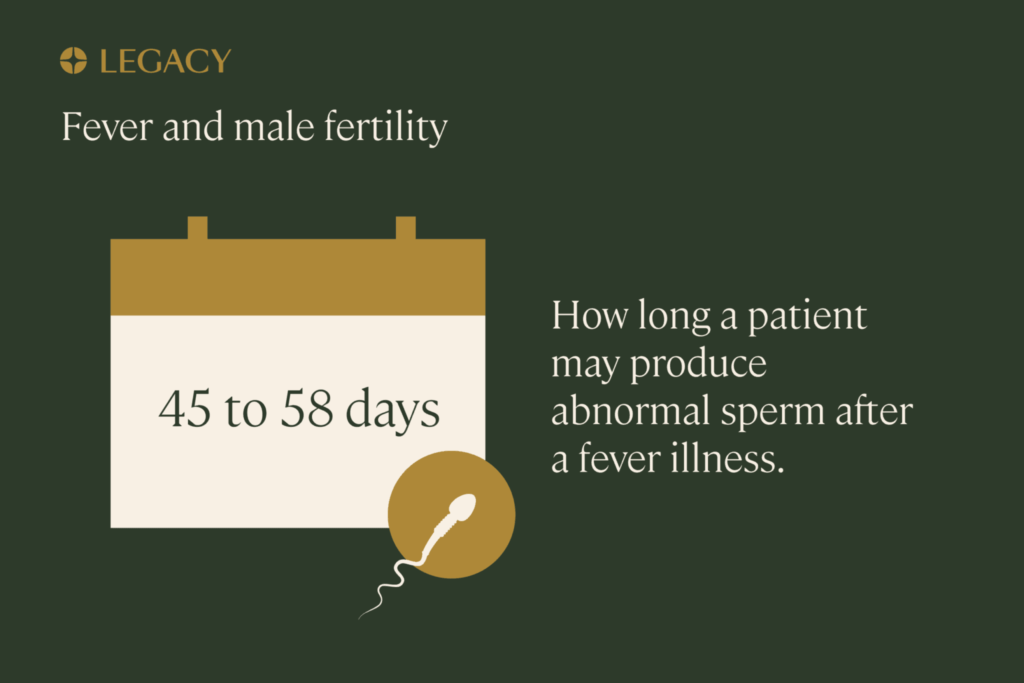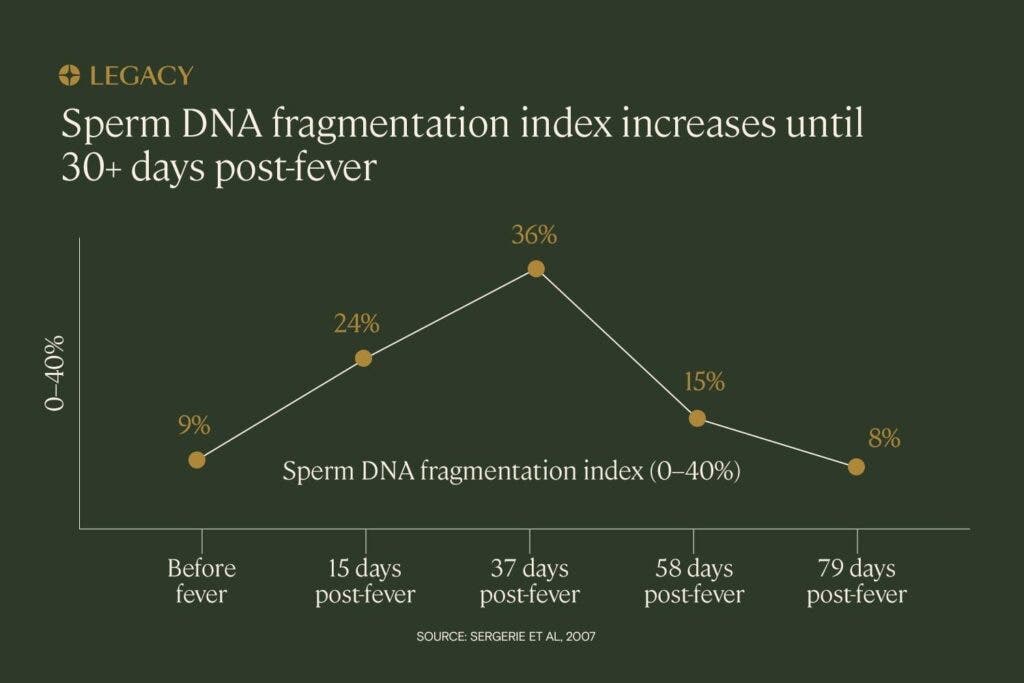If you get the flu, COVID-19, or another illness, you might experience a fever — an unpleasant but temporary increase in body temperature. Fevers usually last a few days at the most, but getting a fever can impact sperm health and fertility for long after you’ve started feeling better. That’s a potentially important consideration if you’re planning to conceive, get a semen analysis, or freeze your sperm. Let’s take a closer look at the research.
Key takeaways
- A fever can temporarily but significantly impact sperm production and quality.
- Fever can impact sperm for 2–4 months. Sperm quality generally recovers after one to two full cycles of sperm production (about 72–90 days post-fever).
- Prolonged high fevers (above 101°F, lasting several days) have a more negative effect on sperm health than shorter or milder fevers.
- Short-lived fevers from vaccinations (e.g., COVID-19) don’t seem to impact sperm quality.
What is a fever?
A fever is a temporary but significant increase in core body temperature. Normal temperature is about 98.6ºF; a fever is generally defined as 100ºF or higher. Fever isn’t considered an illness in itself. It’s an immune system response in which the body elevates body temperature to kill viruses, bacteria, or other pathogens. Common causes of fever include the flu, pneumonia, COVID-19, heat exhaustion, food poisoning, and infections. An illness accompanied by fever is known as “febrile illness.”
No matter how healthy you are, you’re bound to occasionally get a fever. So how does fever impact your fertility? Does a fever kill sperm? Does getting a fever cause any permanent damage to your sperm quality or production?
How body heat affects sperm production
Sperm production, known as spermatogenesis, is sensitive to heat. Ideally, sperm production occurs at about 93.2ºF, about 5ºF below normal body temperature. This is why the testicles hang below the body — to keep the temperature a bit lower. (It’s also why the “height” of your scrotum may change on cooler and warmer days.)
When the temperature of the scrotum or testicles increases, which can happen when you get a fever, sperm production may be impaired significantly. This can lead to fewer sperm and lower-quality sperm with more genetic abnormalities.
Increased scrotal heat can impact sperm production and impair sperm count and quality. In one study, it was found that scrotal heat exposure led to severe reproductive impairment, increasing sperm DNA damage and apoptosis (cell death). Another study found that even a mild rise in testicular temperature significantly increased abnormalities in the DNA inside sperm and significantly decreased normal morphology, a result of disruptions in spermatogenesis.
Research has found that frequently holding laptops on the lap or spending time in saunas can raise the temperature of the scrotum enough to reduce sperm quality temporarily — more evidence that sperm production is sensitive to heat.

How fever affects sperm quality parameters
Multiple studies have found that a sickness that comes with a fever can significantly reduce sperm count and quality, especially when it’s a fever over 101ºF experienced for multiple days.
Fever and sperm count
First, a few important things to understand about fever and sperm count: Sperm count refers to the total number of sperm in the semen. Sperm concentration is the number of sperm per milliliter of semen. Sperm production has a cycle of about 72 days from start to finish.
In a study that observed five men who had fevers of 102.2ºF or greater for 3 or more days, sperm concentration declined up to 7% within 6 weeks following the fever. In one case report, it was found that total sperm count was significantly decreased for up to 2 months after a 2-day fever of 102–104ºF. Another case report of an infertility patient had a similar outcome: sperm concentration dropped to less than half of its original measure just after the fever was resolved.
Another study followed 27 healthy, fertile men with monthly semen analyses. This research reported a 32–35% decrease in sperm concentration for men who experienced febrile illness. This study also found that the number of days the men experienced a fever significantly affected their semen parameters, with a reduced sperm concentration of up to 8.5% per day of fever.
Remember that sperm production takes about three months. The full effects of fever on sperm count may not appear until 2–3 weeks after the illness. That’s important to keep in mind when planning a semen analysis or interpreting the results.
Fever and sperm motility
Sperm motility refers to the percentage of sperm that are moving or “swimming.” Motile sperm are essential for successful fertilization, because immotile sperm are generally not capable of reaching or penetrating an egg.
In one study, it was observed that sperm motility was decreased for over a month post-fever. This observation is supported by the aforementioned study analyzing the effects of fever on 27 fertile men, which found that the percentage of immotile (non-moving) sperm was increased by 20.4% following fever — with an increase of 4.5% per day of fever.
The previously mentioned study of five febrile men also found a decrease in what’s known as “progressive motility,” the ability of a sperm to move efficiently (i.e., in straight lines or large circles as opposed to tight circles). There was a decrease in progressive motility of up to 23% around 6 weeks post-fever.
Fever and sperm morphology
Sperm morphology refers to the percentage of sperm that are the proper size, shape, and structure. Fever can cause morphology to decline. One study found that the percentage of morphologically normal sperm may decrease by over 7% post-fever. Another study was able to get even more specific, finding a significant increase in the number of sperm with abnormally small heads following a fever.
Fever and sperm DNA fragmentation
Sperm DNA fragmentation is a measure of the percentage of sperm that contain damaged or abnormal genetic material. High levels of DNA fragmentation have been associated with lower fertilization rates, impaired embryo development, and higher risk of miscarriage.
One study analyzed the semen sample of a fertile patient who had the flu with a 1-day fever. The sample was analyzed at 18–66 days post fever. At 18 days post fever, 36% of the sperm analyzed demonstrated damaged DNA — considered a high, abnormal level of sperm DNA fragmentation. Another study found severe damage to sperm DNA structure in a fertile patient who had a 2-day fever of 102.2ºF–104ºF.

So, can getting sick affect my fertility?
Yes, it’s certainly possible. Illnesses with fever can temporarily, but significantly, affect your fertility. This may especially be true for people who already have low sperm count or motility, as any additional decrease can further impact chances of conceiving.
Several of the above studies have looked at real-world cases of fever-causing illness, such as influenza or strep throat, and found that they caused a drop in sperm count and quality. Other fever-causing illnesses such as COVID-19 have been shown to significantly impair sperm production, at least in the short term. A 2023 study found that men who’d recently had COVID-19 had inflammatory markers in their semen and “significantly reduced semen volume, lower total sperm counts, and impaired sperm motility and viability,” but these resolved after 1–2 cycles of spermatogenesis. “All observed alterations returned to baseline values after 3 or more months after disease recovery,” the scientists wrote.
Learn more about COVID-19 and male fertility.
However, a short-term or mild fever isn’t likely to have a significant effect. In one study, researchers found no impact on sperm production with a scrotal temperature increase of less than 2ºF. In another, researchers found that the impact was directly related to how long the fever persisted — fevers lasting several days had a more dramatic effect on sperm quality than shorter fevers that lasted less than a day.
Can getting a vaccine affect my fertility?
Some vaccines, such as the COVID-19 vaccine, may cause a slight fever after injection. This is part of the normal immune system response to vaccination. However, the fever caused by vaccination is much shorter and milder than the fever that’s possible with infection, and it’s less likely to impact sperm.
Studies of the COVID-19 vaccine, for example, have shown that vaccination has no impact on sperm health. One study published in JAMA reported that healthy men had no statistically significant changes in sperm concentration, motility, or morphology after getting the mRNA COVID-19 vaccine.
How long will it take my sperm to recover from a fever?
The good news is that the effects of a fever on sperm production aren’t permanent.
One study of scrotal heating noted that the effects on sperm production were reversible and that normal sperm production could be recovered after two cycles of spermatogenesis. Case studies of patients with febrile illness have reported that normal sperm production resumed after anywhere from 20 to 45 to 79 days post-fever.
So, if you’ve recently had a bad fever, you can expect your sperm quality and production to return to pre-fever levels about two to four months post fever.
Should I do a semen analysis if I recently had a fever?
We don’t recommend it, because the analysis may not be accurate. If you’ve recently had a fever, it’s a good idea to wait until at least two months after the fever has subsided.
For the most accurate semen analysis, you may also want to abstain from ejaculation for 2–5 days before producing your sample. To learn more about how to prepare for a semen analysis test and what to expect, check out our guide to sperm testing.
Wondering if testing or freezing are right for you? Answer a few quick questions to find the best plan for a personalized plan:



